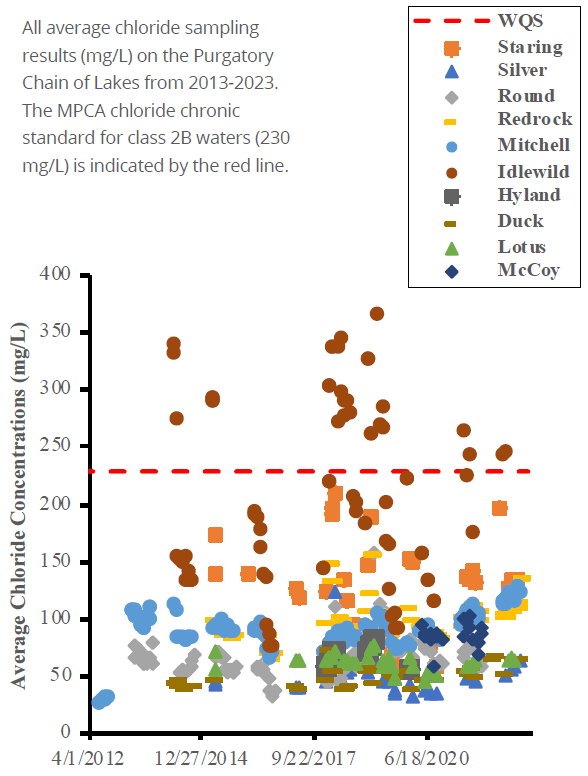Chloride
The leading source of chloride pollution in Minnesota waters is from deicing chemicals (salts) used in winter maintenance. About 50 waterbodies in Minnesota already have dangerous chloride levels, and another 75 waterbodies are close to the danger zone. Learn more about chloride pollution from the Minnesota Pollution Control Agency.
Chloride Pollution in RPBCWD
RPBCWD staff have monitored chloride (salt) pollution in lakes, ponds, and streams since 2013. Because its difficult and expensive to remove, chloride is considered a permanent pollutant, and it takes only one teaspoon of salt to permanently pollute one gallon of water. Unfortunately, many chloride levels are trending upward in the district.
At high concentrations, chloride harms fish, aquatic plants, and other aquatic organisms. Chloride concentrations are typically highest in late winter and early spring due to snow and ice melting events. For now the average chloride levels in our lakes remain below the MPCA water quality standard for chloride, but individual samples from some lakes are above the standard, which means the water at the sampling location had a toxic level of chloride at the time of the sample.
The charts below show the chloride levels in lakes in the Purgatory Creek system and the Riley Creek system over the last 10 years. The dashed red line represents the water quality standard for lakes. Lake Idelwild (technically a high value wetland and not a lake) is in the Purgatory Creek watershed has chloride levels regularly above the standard. In the Riley Creek watershed, both Susan and Rice Marsh lakes had samples above the chloride standard in the last couple of years.


Monitoring data from Riley, Purgatory, and Bluff creeks show an upward trend in chloride pollution as well. Chloride concentrations vary through the year with higher values occurring in spring and early summer.
See chloride trends for individual waterbodies in the lake and creek factsheets.
Prevention is Key
Currently the only feasible way to address chloride pollution is through prevention. RPBCWD partners with cities, the MPCA, and others to host trainings for winter maintenance professionals and propery managers. The District also promotes less winter salt use through social media, classroom visits, and public events.
Many cities have fine-tuned their road salting programs to reduce chloride use while maintaing safety. Improvements include calibration of equipment to reduce over-application, use of brine instead of rock salt, and close monitoring of weather to optimize application timing. A new approach is designing roads, parking lots, and other infrastructure in a way that reduces the need for winter salt. Read the article on how the City of Eden Prairie is doing this.
Learn about what you can do to prevent chloride pollution.
